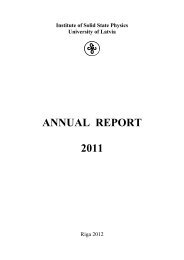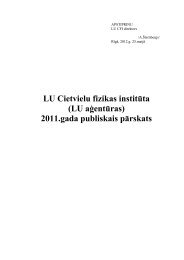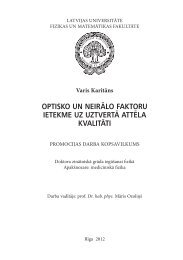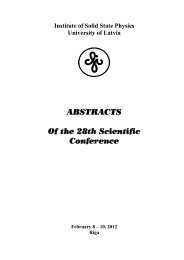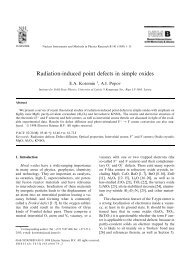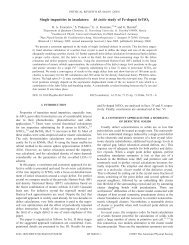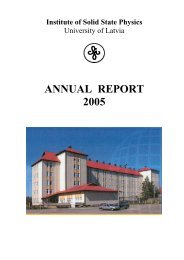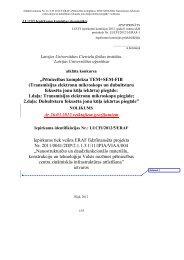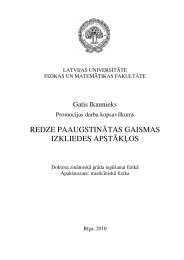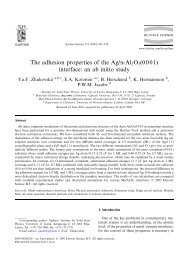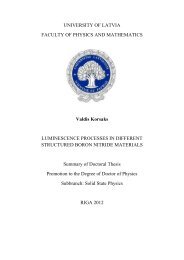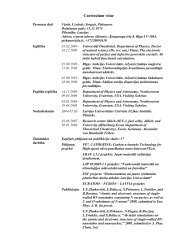Annual Report 2012 - Latvijas Universitātes Cietvielu fizikas institūts
Annual Report 2012 - Latvijas Universitātes Cietvielu fizikas institūts
Annual Report 2012 - Latvijas Universitātes Cietvielu fizikas institūts
Create successful ePaper yourself
Turn your PDF publications into a flip-book with our unique Google optimized e-Paper software.
The synthesized compounds ZWK-1, DWK-1, JWK-1 and ZWK-2, DWK-2, JWK-2 form a<br />
glassy structure in the solid state from volatile organic solvents. The glass transition temperature<br />
of almost all compounds is higher than 110ºC. Absorption maxima lie between 450 nm to 550<br />
nm, depending on electron acceptor and electron donor groups in the compound structure. The<br />
maximum of luminescence spectra is observed between 580 nm and 690 nm. In the case of twodonor<br />
groups (ZWK-2, DWK-2, JWK-2) the luminescence spectra consist of two bands in solid<br />
state compared to the solution. The second band is attributed to the excimer states. The<br />
photoluminescence quantum yield in solution is up to 0.54. It drops one order of magnitude in<br />
the solid state due to the closer intermolecular distance between molecules and probable<br />
formation of a high density of dimers, which results in a strong excitonic interaction in the thin<br />
solid films. Incorporation of bulky trityloxyethyl groups results in less aggregate formation of<br />
the dye molecules in the polymer films compared to the same type of molecules without the<br />
trityloxyethyl groups.<br />
FLUORESCENCE AND AMPLIFIED SPONTANEOUS EMISSION OF GLASS<br />
FORMING COMPOUNDS CONTAINING STYRYL-4H-PYRAN-4-YLIDENE<br />
FRAGMENT<br />
Aivars Vembris 1 , Inta Muzikante 1 , Renata Karpicz 2 , Gytis Sliauzys 2 , Arunas<br />
Miasojedovas 3 , Saulius Jursenas 3 and Vidmantas Gulbinas 2<br />
Potential of glassy films of newly synthesised low molecular weight organic molecules for light<br />
amplification and lasing applications has been investigated by analysing fluorescence, transient<br />
differential absorption and amplified spontaneous emission properties. These non-symmetric and<br />
symmetric molecules contain styryl-4H-pyran-4-ylidene fragment with three different electron<br />
acceptor groups: dicyanomethylene, barbituric acid, indene-1,3-dione. Fluorescence quantum<br />
yields of the investigated compounds in solutions are between 0.32 and 0.54, while they drop<br />
down by an order of magnitude in thin solid films. Incorporation of bulky side groups reduced<br />
excitonic interactions enabling manifestation of amplified spontaneous emission in the neat films<br />
of the investigated derivatives.<br />
Figure 1. Styryl-4H-pyran-4-ylidene fragment<br />
containing derivatives ZWK-1, ZWK-2,<br />
JWK-1, JWK-2, DWK-1, DWK-2.<br />
Figure 3. Absorption (thin solid line),<br />
fluorescence (dashed line) and differential<br />
absorption (thick solid line) spectra of all<br />
115



